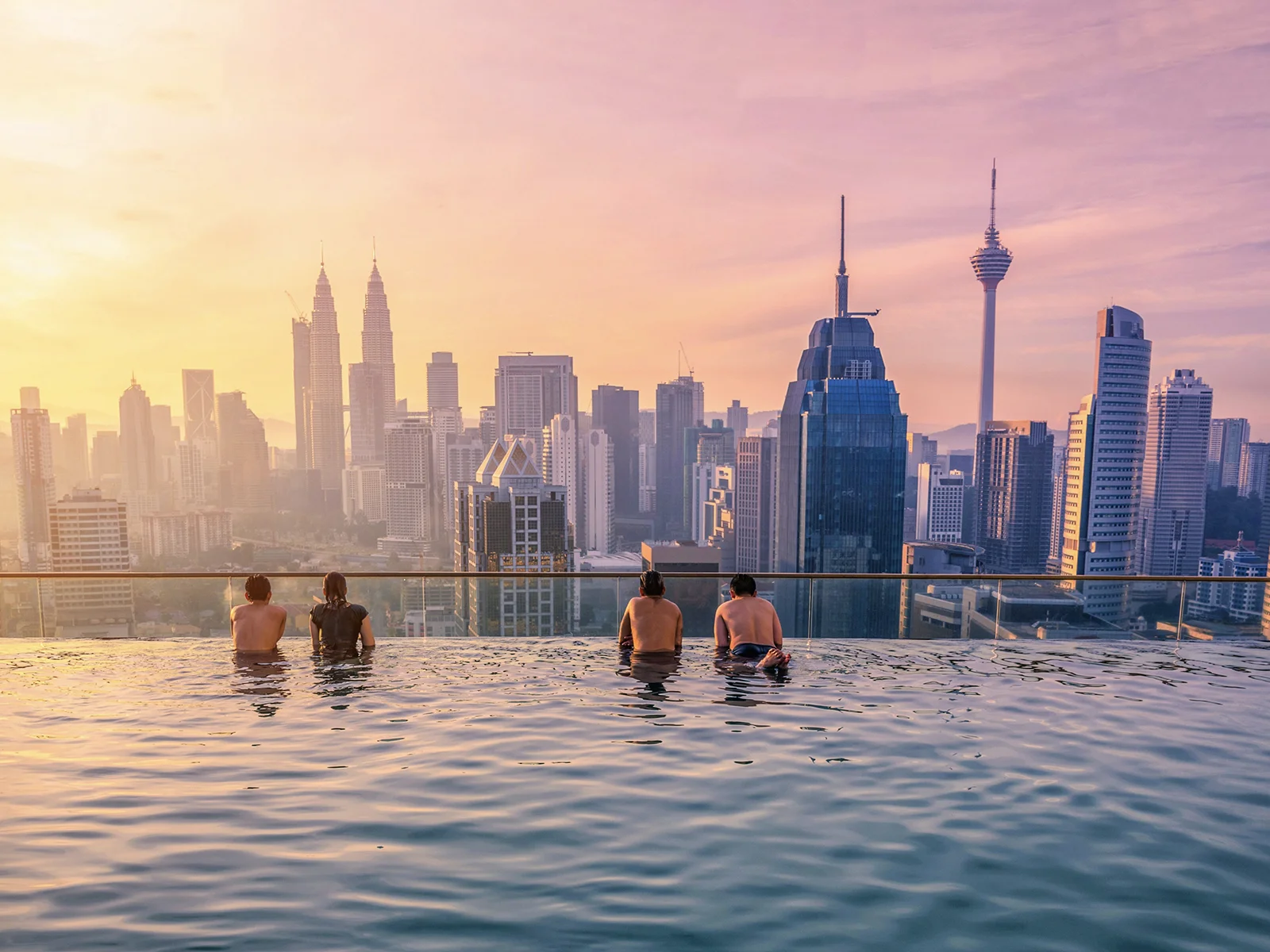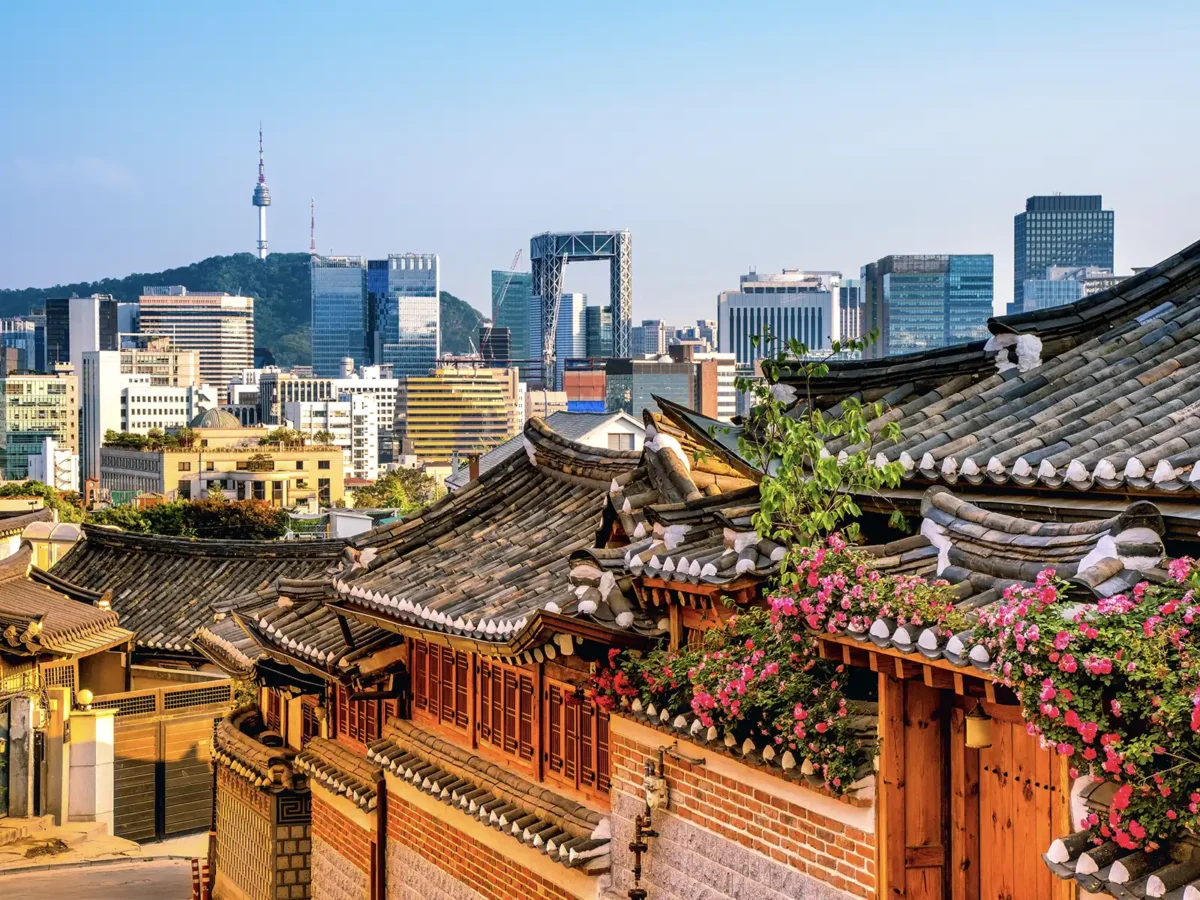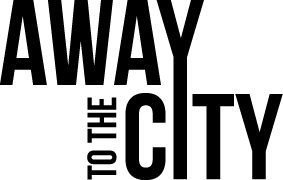12 Best Things to Do in Kuala Lumpur: Top 2025 KL Activities
This post may contain affiliate links, including from Amazon and other trusted partners. If you click a link and make a purchase, we may earn a small commission at no extra cost to you. That said, we only recommend products and services we genuinely use and love. Learn more in our Privacy Policy page.

Kuala Lumpur can feel like a lot all at once. You’ve got temples next to glass towers, old British buildings beside street food stalls, and malls bigger than airports. If it’s your first visit, it’s hard to know what’s actually worth seeing.
We came here for the first time in 2019, planning to stay three nights. Then the skyline views, colourful temples, and late-night markets pulled us in. We extended our stay… and have been back twice since. Each trip helped us figure out what’s genuinely worth your time and what you can skip.
In this guide, we’re sharing 12 of the best things to do in Kuala Lumpur, including rainbow stairs at Batu Caves, street food on Jalan Alor, and the temple we always recommend to friends. You’ll also find tips on where to stay, how to get around, and a few underrated spots we think more visitors should know about.
If you’ve only got a few days in KL, this list will help you focus on the things that matter most.

Don’t miss these!
Our Top Picks for Your Kuala Lumpur Trip
KL is one of the world’s most visited cities, so be sure you have hotels and tours booked ahead of time. Here are the ones we’d happily book again:
![]() Top KL experiences
Top KL experiences
- Sambal Street Food Tour with 15+ tastings (our #1 pick, the ultimate way to eat your way through KL’s street food scene)
- Batu Caves & suburbs tour (super easy half‑day excursion to KL’s top temple)
- Views from KL Tower (THE best skyline views in KL, top-rated observation deck that often sells out)
![]() Best places to stay in Kuala Lumpur
Best places to stay in Kuala Lumpur
- Capri by Fraser Bukit Bintang (spacious rooms and an excellent rooftop pool, we’d stay here again in a heartbeat!)
- Ascott Star KLCC (luxury stay with Petronas Tower views, totally worth the splurge)
12 Best Things to Do in Kuala Lumpur, Malaysia
KL is Malaysia’s cultural, financial, and economic heart, known for its mix of modern skyscrapers, colourful temples, and one of the best street food scenes in Southeast Asia.
It’s also a brilliant introduction to Malaysia’s multicultural roots. You’ll find Malay, Chinese, and Indian influences shaping everything from the architecture to the food.
Here’s our pick of the best things to do in Kuala Lumpur – the ones that genuinely deserve a spot on your itinerary:
1. Climb the colourful steps to Batu Caves
Around 35 minutes by train from the centre of Kuala Lumpur, you’ll find the famous Batu Caves. These natural limestone caves and temples are closely tied to Hindu traditions and have been an important pilgrimage site for generations.

Did you know? Batu Caves are thought to be around 400 million years old, which means they even predate the dinosaurs.

The caves are dedicated to Lord Murugan, the Hindu god of war. At the entrance, you’ll see his golden statue rising 43 metres (140 feet) high. It’s the second-tallest statue of a Hindu deity in the world.



If you’re heading up the 272 rainbow-coloured steps, keep your wits about you. The monkeys here don’t hold back. We saw them grab water bottles, sunglasses and even bags from visitors.
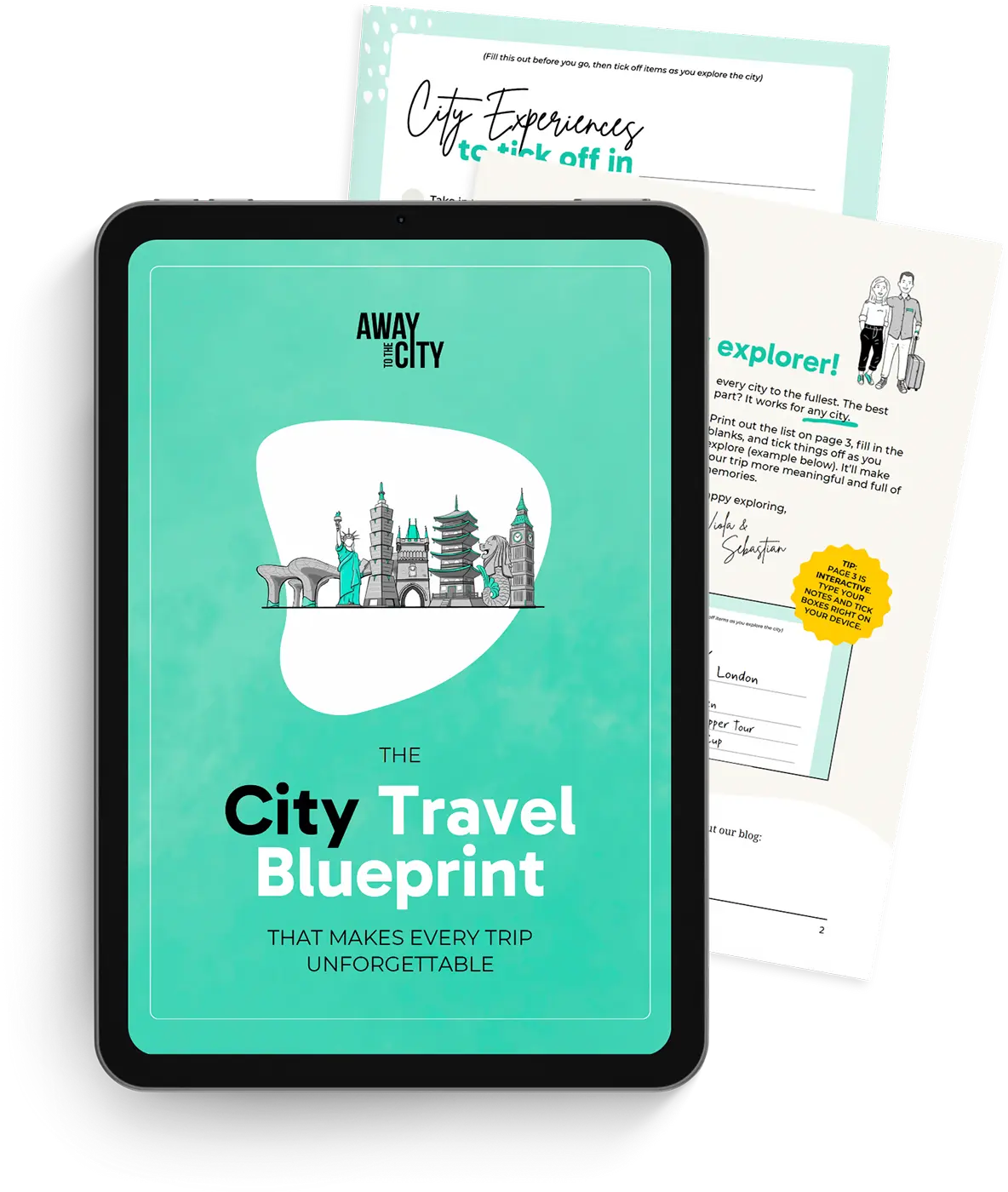
The secret to choosing what’s worth doing in any city
Exploring hundreds of cities taught us a simple method for planning meaningful trips. Our FREE City Travel Blueprint gives you a clear structure you can fill in and use for your next trip.
Much like the monkeys in Gibraltar (the only place in Europe where you can encounter wild monkeys), they’re notorious for snatching food, drinks or any loose belongings from tourists.

Our top tips for visiting Batu Caves
- Get there early if you can. It’s cooler and much quieter in the morning.
- You can take the KTM Komuter train or book a Grab taxi (Southeast Asia’s equivalent of Uber). Both are easy and reliable.
- Bring water with you. You’ll need it after the steep climb!
- Keep your phone and belongings close. Honestly, we saw monkeys unzip bags with surprising confidence.
- We booked this 3.5-hour tour on GetYourGuide that included Batu Caves, a pewter factory, a batik workshop and a traditional Malay village. It was a brilliant way to see more of the countryside, and we’d definitely recommend it! The same tour is also available on Klook.
Admission and opening hours: The main Batu Cave is free to enter, but some of the others charge a small fee. Opening hours are daily from 7am-9pm.
🐒 This half-day Batu Caves tour combines history, great views and zero logistics stress.
2. Take in the panoramic views from KL Tower
KL Tower (also known as Menara Kuala Lumpur) is one of the city’s most iconic landmarks and a brilliant spot for taking in Kuala Lumpur from above.


At 421 metres (1,381 feet), it’s one of the tallest freestanding towers in the world. We’ve tried a few of KL’s viewing points, and this one wins hands down.
The views from the top stretch all the way across the city. In our opinion, it’s one of the best sightseeing spots in KL, and we’d pick this over the Petronas Towers any day.
There’s an indoor observation deck at 276 metres (906 feet), plus the outdoor Sky Deck at 300 metres (984 feet). If you’re feeling brave, you can step into the glass Sky Box for a photo with the city below your feet.

Our Top Tips for Visiting KL Tower
- Skip the indoor-only ticket and go for one that includes the Sky Deck. The outdoor view is so much better.
- If you want to try the Sky Box, you’ll be given a number when you arrive at Level 5. Each person gets 90 seconds inside the box, so make sure you both grab a number if you’re going with someone.
- We booked our tickets through Klook and found it cheaper than the official website or other booking websites, so it’s worth checking.

Admission and opening hours: Official ticket prices for foreign visitors start from MYR 80 (around £14, €16, or US$19) for the indoor deck, but they’re often cheaper on Klook. KL Tower is open daily from 9am-10pm.
![]() Skip the lines and book your KL Tower tickets on Klook, often cheaper than elsewhere.
Skip the lines and book your KL Tower tickets on Klook, often cheaper than elsewhere.
3. Explore Kuala Lumpur’s food scene
Kuala Lumpur’s easily one of the best food cities in Asia. You’ll spot it in the markets, food courts, back alleys and streets where smoky grills and plastic chairs take over after dark.
It’s a mix of Malay, Indian and Chinese flavours all in one place. Brilliant, but a bit much to figure out on your own.
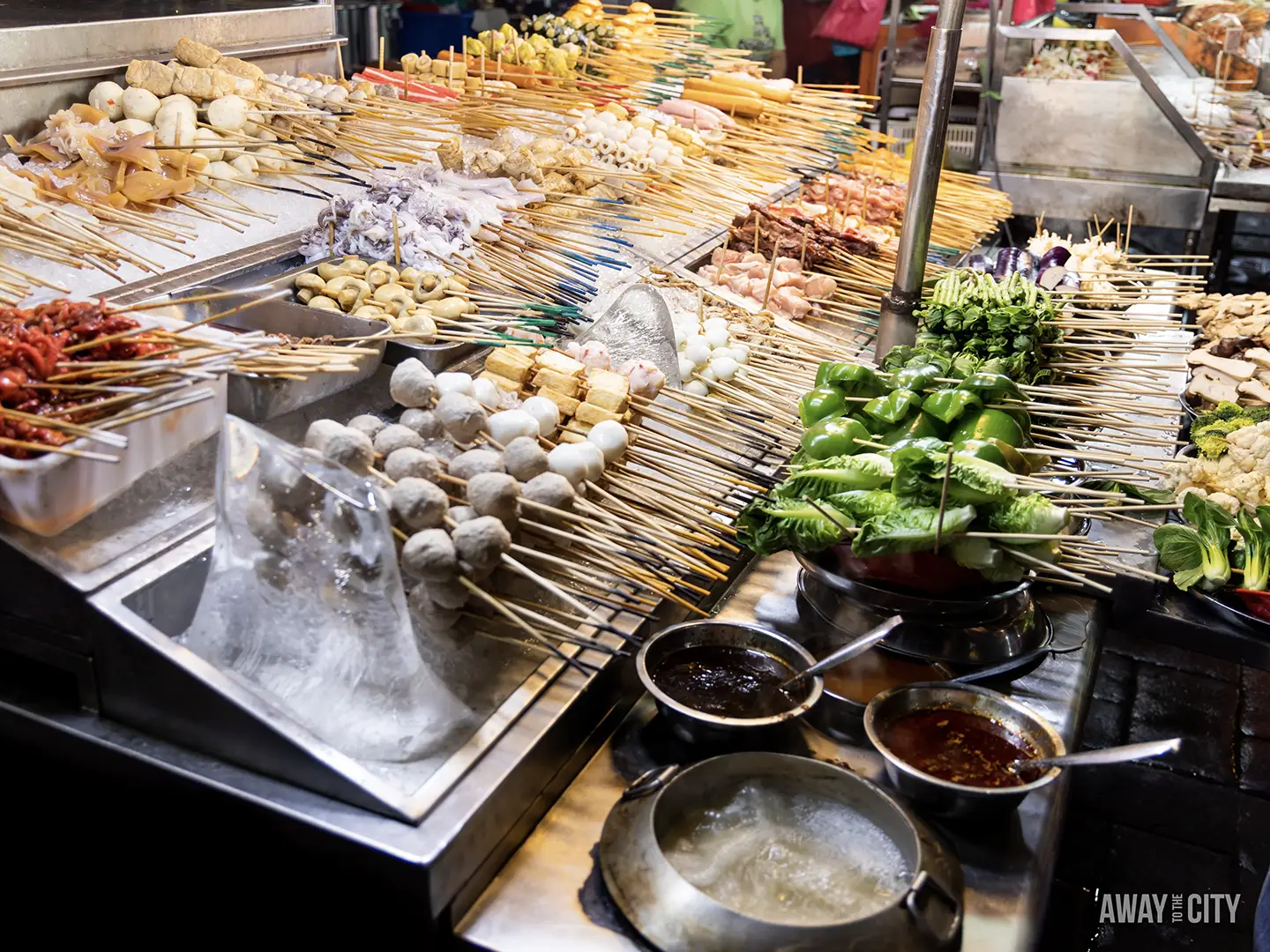
That’s why we booked this Sambal Street Food Tour, and honestly, it was the best decision we made on our trip! It’s a 4-hour walk through two of the city’s most traditional neighbourhoods, with over 15 tastings along the way.
We tried everything from hand-stretched roti and grilled mackerel with sambal, to nasi lemak, cendol and durian.
The food kept coming, the portions were generous (we started splitting dishes halfway through), and nothing about it felt touristy. There’s no way we’d have found these local spots on our own, no matter how much research we did beforehand.
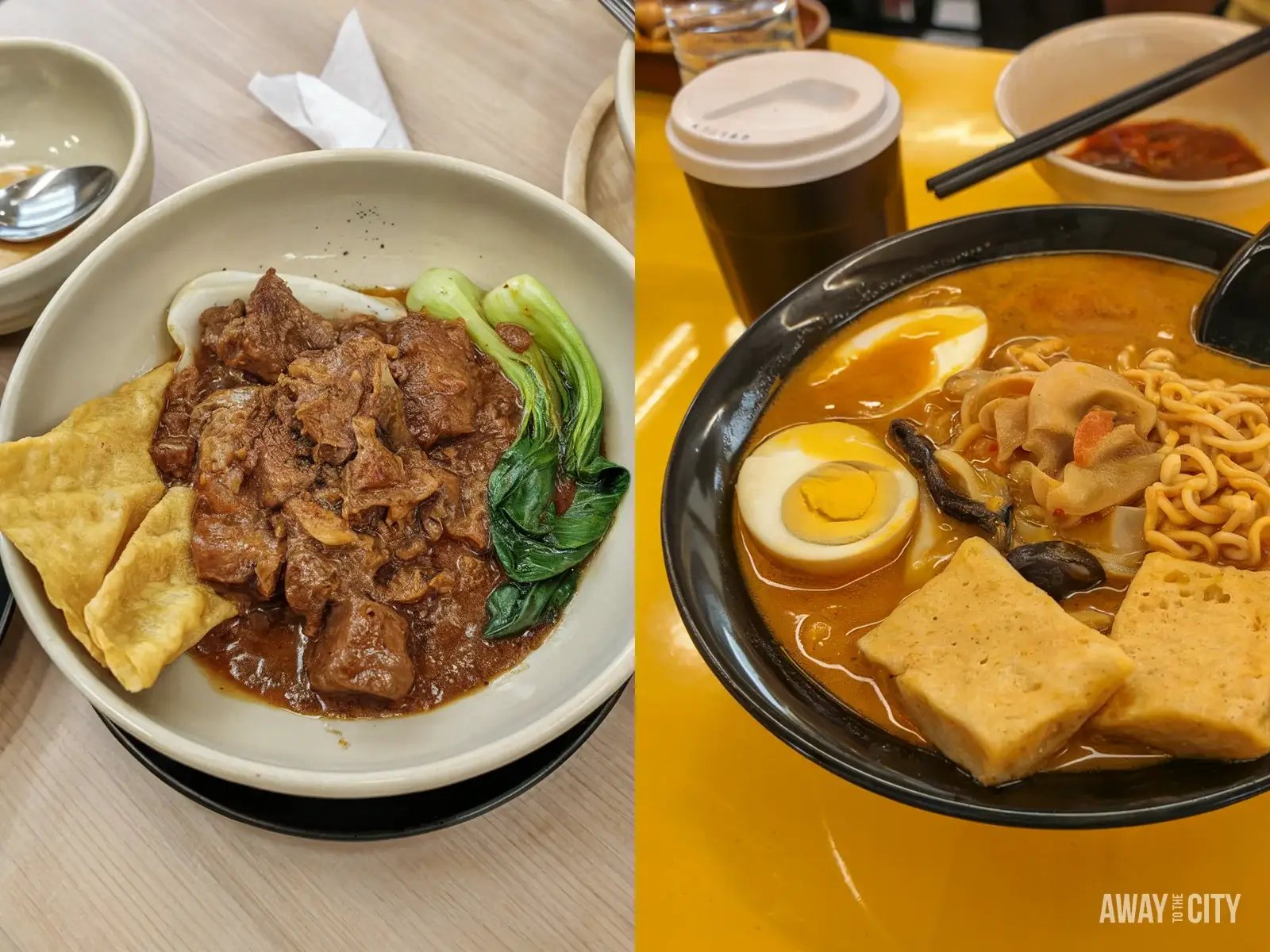
If you’re out on your own, Jalan Alor Food Street is still a great shout. It’s one of the busiest food streets in KL and gets lively from about 6pm. You’ll find satay, noodles, grilled seafood and plenty of snacks, all for decent prices.
🍛 Want to eat like a local without getting lost? This 4-hour food tour was one of the highlights of our KL trip.
4. See the iconic Petronas Twin Towers
Right in the heart of Kuala Lumpur City Centre (KLCC), the Petronas Twin Towers are one of those must-see landmarks, especially if it’s your first time in the city. They’re impossible to miss and are considered the city’s main attraction.

Did you know? The Petronas Towers still hold the record as the tallest twin towers in the world.
Built in 1998, they were once the tallest buildings globally until 2004. They’re linked on the 41st and 42nd floors by the highest two-storey skybridge in the world, which is just one of the things that makes them such a fascinating bit of architecture.

The towers’ design is heavily influenced by Islamic art and culture. Their floor plan follows geometric patterns traditionally found in Islamic design, and you’ll notice the motifs continue right through to the exterior detailing.
You can go all the way up to the 86th floor where the views are brilliant. That said, the views from KL Tower are a bit better in our opinion, since you get the Petronas Towers in your skyline shots.

Our top tip: The observation deck of the Petronas Twin Towers is quite popular, so book your tickets at least a week in advance if you want a specific time slot or day. They often sell out. If we had to choose, sunset is the one to go for. The city looks beautiful as the lights come on.


Once you’re done, make your way to Suria KLCC at the base of the towers. It’s a glossy 6-story shopping centre with plenty of places to eat, or you could stretch your legs in KLCC Park nearby.
The fountains, water features and landscaped gardens of KLCC Park offer a bit of calm right next to all the high-rise buzz. Also, stick around in the evening to catch the Lake Symphony show (KL’s free fountain display set to lights and music) right outside Suria KLCC. It happens at 8pm, 9pm and 10pm daily.
Admission and opening hours: Entry to the Petronas Twin Towers is MYR 130 (about £23, €26 or US$31) for foreign visitors. The observation decks are open from Tuesday to Sunday, 9am-9pm. They’re closed on Mondays.
5. Visit Thean Hou Temple, one of Southeast Asia’s oldest temples
Set on a hill just outside the city centre, Thean Hou Temple is one of the oldest and largest Chinese temples in Southeast Asia. Built by Malaysia’s Hainanese community in 1989, it’s dedicated to the sea goddess Mazu and blends Buddhist, Taoist and traditional Chinese influences.
You can make your way up through six levels, with red lanterns hanging overhead, colourful details everywhere, and a peaceful atmosphere that feels far from the city below.
It’s still very much a working temple, but it also doubles up as a cultural spot. We even saw a wedding while we were there. In fact,it’s a popular location for Chinese weddings. Lots of couples come here to have their marriage blessed.

Head up to the top tier for some brilliant views across KL. Sunset is a great time to go, especially when the city starts to light up and everything feels a bit magical.
Our Top Tips for Visiting Thean Hou Temple
- If walking uphill isn’t your thing, Grab (Southeast Asia’s equivalent of Uber) is your best bet. We wouldn’t recommend taxis unless you’ve already arranged for the driver to wait. A few people we spoke to ended up paying extra just to make sure they had a ride back.
- Aim to arrive before sunset. You’ll get great light for photos, and it’s a lovely place to relax as the sun goes down.
- Dress modestly! It’s still a place of worship, so leave the crop tops and mini skirts behind for this one.
Admission and opening hours: Entry is free and the temple is open daily from 8am-10pm.
6. Explore the Sultan Abdul Samad Building & Merdeka Square
Located in the heart of the city, the Sultan Abdul Samad Building is one of Kuala Lumpur’s most beautiful buildings and a true standout landmark. Built in 1897 during British colonial rule, it was originally used for government offices.
The design is classic Moorish revival, with arched windows, clock towers and gleaming copper domes that still catch your eye today.


Just in front is Merdeka Square (Dataran Merdeka in Malay), which holds a special place in Malaysian history. This is where the country’s independence was officially declared on 31 August 1957.
These days, the square’s used for national events and gatherings, and it’s a great stop if you’re into a bit of history and local pride.

You can’t go inside the Sultan Abdul Samad Building, but it’s a brilliant spot for photos, especially with the wide backdrop of the square.

Our top tip: Take a walk along the riverside path behind the building. It offers a different perspective and leads you directly to the Sultan Abdul Samad Jamek Mosque (or Masjid Jamek). As one of the oldest mosques in Kuala Lumpur, it’s a beautiful spot to pause, and you’ll also get some lovely views of the Klang River along the way.


Admission and opening hours: It’s free to admire the building and square from outside, and it’s open 24/7.
7. Discover Rumah Penghulu Abu Seman
Rumah Penghulu Abu Seman is one of the city’s oldest surviving traditional Malay houses right in central KL. It was originally built between 1910 and the early 1930s, and while it might not look like much from the outside, don’t let that put you off because the inside is full of charm and history.

The house is a lovely example of classic Malay architecture. There’s beautifully carved timber, restored furnishings and loads of original details that give you an idea of what village life used to be like.

Did you know? A penghulu is a village chief, and this house once belonged to Penghulu Abu Seman himself.

These days, the house is surrounded by KL’s high-rises, but stepping inside gives you a real feel for a different time.
You can only visit the interior with a guided tour. Our guide shared loads of stories that really brought the place to life.

Our top tip: Go for the guided tour! It’s the only way to see inside, and honestly, it makes all the difference. You’ll leave with a much better feel for traditional Malay life and the role of a village headman.



Admission and opening hours: The entrance fee is MYR 20 for foreign visitors (about £3, €4, or US$5), and entry is by guided tour only. Tours run Tuesday to Saturday at 11am and 3pm.
![]() Tickets for Rumah Penghulu can only be bought at the on-site ticket office.
Tickets for Rumah Penghulu can only be bought at the on-site ticket office.
8. Wander through Chinatown’s Petaling Street
Chinatown in KL is centred around Petaling Street and has been part of the city since the mid-1800s, when Chinese immigrants settled here and brought their traditions with them.
These days, it’s a lively area packed with stalls, street food, and the kind of local markets that make exploring KL so fun.


The streets are lined with vendors selling everything from knock-off sunglasses to herbal remedies and handmade trinkets. It’s the kind of place where you never quite know what you’ll stumble across, which is part of the fun.
Make sure you turn up hungry… the food here is brilliant! Try dishes like Char Kway Teow (stir-fried noodles), Hainanese Chicken Rice or Nasi Lemak (coconut rice). You’ll find loads of stalls offering quick bites at good prices.


Our top tip: Go in the evening if you can. The market feels much more alive after dark with its bright lights, crowds and busy atmosphere. Don’t be shy about haggling, and definitely try more than one food stall (we couldn’t pick just one!).

If you’ve got a bit of extra time, stop by Central Market (Pasar Seni). It’s just around the corner and known for its local crafts and souvenirs. We’ll be honest: the Art Deco building is more of a draw than the market itself, but it’s worth a look if you’re nearby and into architecture.
Admission and opening hours: Chinatown is free to explore and technically open all day, though most stalls and food spots are busiest in the evening.
9. Relax at Perdana Botanical Garden
Perdana Botanical Garden (also called Taman Botani Perdana or Lake Gardens) is one of the best places in KL to take a breather. It covers 92 hectares of landscaped gardens, forested patches and calm lakes, all just a short distance from the city centre.

First opened in 1888 as a colonial-era experimental garden, it’s since grown into a proper urban park with lots of themed areas to explore.
You’ll find the Hibiscus Garden (showing off Malaysia’s national flower) and a shaded Fern Garden that’s perfect for a slower stroll. There’s even a small Deer Park tucked away inside.

One of our favourite parts of the park is Laman Perdana, a large open square where events and community activities are often held. The eye-catching yellow structure above it, known as the Perdana Canopy, adds a modern contrast to all the greenery and has become a popular photo spot.

While you’re in the area, take a short walk over to the National Monument (Tugu Negara). It’s a striking bronze sculpture dedicated to Malaysians who died fighting for the country’s freedom, especially during World War II and the Malayan Emergency.
Admission and opening hours: Perdana Botanical Gardens are free to enter. It’s open from 7am-6pm on weekdays, and 7am-8pm on weekends.
10. Admire the Sri Maha Mariamman Temple
Sri Maha Mariamman Temple is one of those places that really shows off KL’s mix of cultures. Built in 1873, it’s the oldest Hindu temple in the city and still very much a part of daily life for many locals.

The temple is dedicated to Mariamman, a goddess known for her healing powers.
The front facade is especially striking, covered in colourful sculptures and mythological figures that tell stories from Hindu tradition. We were genuinely blown away by the detail.


Our top tip: Don’t just admire it from outside, but head in for a proper look! You’ll need to take your shoes off before entering, and there’s a spot right next to the entrance where you can store them for MYR 0.30 (less than £/€/US$0.10).
Admission and opening hours: Visiting Sri Maha Mariamman Temple is free. It’s open from 6am-8pm on Monday, 6am-8:30pm on Tuesday-Thursday and Sunday, 6am-9:30pm on Friday, and 6am-9pm on Saturday.
11. Experience the vibrant culture along Jalan Masjid India (Little India)
Jalan Masjid India, or “Indian Mosque Street”, is one of KL’s oldest districts and a key part of the city’s Indian heritage. It’s named after a mosque in the area and has been a central spot for the Indian community in Kuala Lumpur for generations.
This part of the city is full of energy, with market stalls selling everything from colourful saris and gold bangles to fragrant spices and sweet snacks. You’ll find a mix of architecture here too, with colonial-era buildings sitting alongside newer structures.

Our top tip: The area is famous for its night market, which takes place every Saturday evening from 5pm to 11pm. It’s always busy. If you’d rather avoid the crowds, show up early. You’ll have a bit more space to browse the stalls before it gets packed.
There’s also a bustling food court where you can try dishes like biryani, samosas and gulab jamun. Honestly, just follow the smell of spices and you’ll end up in the right place.
Admission and opening hours: Exploring Jalan Masjid India is free and can be done 24/7, though the night market is the highlight.
12. Go shopping in KL’s mega malls
You don’t need to be a shopping fanatic to enjoy a trip to one of Kuala Lumpur’s many malls!
With over 60 malls around the city, they’re a great way to cool off with some much-needed air conditioning. Plus, you can grab a bite and maybe pick up something you didn’t know you needed.

One we’d definitely recommend is Pavilion Kuala Lumpur. It’s in Bukit Bintang, KL’s go-to area for shopping and entertainment (which reminded us a lot of Singapore’s Orchard Road).
Pavilion has ten floors and more than 700 stores, plus a cinema and plenty of food spots for when you need a break.

Another favourite is Berjaya Times Square. This one’s packed with over 1,000 shops, but what really makes it stand out is the indoor theme park. It’s home to Malaysia’s largest indoor roller coaster.


Admission and opening hours: The malls are free for everyone to explore, with most stores open from 10am-10pm daily.
Interactive Map: Top Activities and Must-See Spots in KL
To help you get your bearings, we’ve created an interactive map that shows you exactly where all the top spots and activities from this post are located across Malaysia’s capital.
It’s a great way to see how everything fits together and plan your day around what’s nearby.

How to use this map: Click the icon in the top left to see the full list of locations. For a bigger view, open it in a new tab via the top-right icon. You can also save it to your own Google Maps by clicking the star next to the map title.
Other Sights & Activities in Kuala Lumpur
For our city guides, we only include the places we genuinely think are the best. That said, if you’ve got more time in KL and fancy seeing a bit more, here are a few extra spots that didn’t quite make the final list but are still worth a look:
Sunway Lagoon – Just 15 minutes outside of KL, Sunway Lagoon is huge. It’s made up of seven parks with everything from water slides to roller coasters and even a small wildlife area, making it one of KL’s top amusement parks. The water park was much bigger than we expected, so if you’ve got a full day to spare, it’s a fun way to spend it.
Genting Highlands – About 45 minutes from the city, Genting Highlands offers a mix of cool mountain air, strawberry farms and rainforest views. There’s also a casino, a theme park and plenty of food stops. You can easily book a day tour from KL to Genting Highlands (as we did) to get a taste of Malaysia’s breathtaking scenery. It’s a good change of pace if you want a day out of the city.
National Mosque of Malaysia (Masjid Negara) – This is one of the most important religious buildings in the city and a beautiful example of Islamic architecture. It’s right by the Old Kuala Lumpur Railway Station, so it’s easy to see both in one go. If you’ve already covered the main highlights, this one’s a nice extra to add.
KL Forest Eco Park (Bukit Nanas Forest Reserve) – This rainforest reserve is right in the city and is known for its canopy walk. We truly enjoyed it on our first KL trip, but it hasn’t been well maintained in recent years. If you’ve never seen a natural rainforest in the middle of a city, it might still be worth a quick visit. Just go with realistic expectations.



Aquaria KLCC – Located beneath the KL Convention Centre, Aquaria KLCC is home to a good mix of marine life. It’s well done but a bit smaller than other aquariums we’ve visited.
National Museum (Muzium Negara) – This is a decent place to learn about Malaysian history and culture, especially if you enjoy museums. It’s set out in chronological order, but if you’re short on time, we’d say head straight to the Malay Kingdoms gallery.
Kuala Lumpur Bird Park (Taman Burung KL) – This place is often described as a free-flight aviary, and while you will see birds roaming, many are still kept in cages. There are over 3,000 birds here from Malaysia and beyond, but it might not be everyone’s cup of tea.
National Palace (Istana Negara) – The exterior of this Malaysian Royal Palace is magnificent and quite imposing, but you can’t go inside (you can walk around outside).
Best Time to Visit
Perfect month to visit: February
Thanks to its tropical climate, Kuala Lumpur is a year-round destination. Temperatures don’t change much, but the number of rainy days and sunshine hours can make a difference to your trip.
If it’s your first time in KL and you want the most reliable weather, we’d say February is the sweet spot. It usually has the least rain and loads of sunshine, which makes it ideal for getting around and making the most of your time outdoors.

As illustrated in our graphic above, May to August is another great stretch with a good mix of sun and fewer wet days. January and March are also decent options.
The rest of the year tends to be a bit wetter or more overcast, but it’s still very possible to enjoy KL. Just bring a compact umbrella and plan for a few indoor stops along the way.
How Long to Stay
Perfect duration to visit: 4 days
How long you stay in Kuala Lumpur really depends on how quickly you like to travel and what you’re hoping to see. That said, we’d recommend giving yourself 4 full days.
It’s enough time to take in the main landmarks, explore a few different neighbourhoods and still have time for things like food markets and museums.

If you’re here on a shorter trip or just a stopover, you can still squeeze in the highlights in 2–3 days. It might feel a bit rushed, but it’s doable.
With 4 days, you’ve got room to slow down a little and even fit in a day trip (somewhere like Genting Highlands or Melaka works well for that).
Where to Stay
Best Neighbourhoods in Kuala Lumpur
If it’s your first time in Kuala Lumpur, we’d recommend staying in one of these three neighbourhoods: Bukit Bintang, Kuala Lumpur City Centre (KLCC), or Chinatown.
You can see KL’s best districts for first-time visitors in our illustrated map below:

Recommended Hotels
We stayed in a few different hotels during our trips to Kuala Lumpur. These were our favourite hotels:
FAQ: Visiting KL
Planning a trip to KL? Here are a few common questions that might help as you sort out the details:
Is Kuala Lumpur worth visiting?
Definitely. KL is a great mix of modern towers, historic temples, buzzing street markets and some seriously good food. It’s a city that brings together different cultures in a way that’s both easy-going and full of character.
And with budget flights linking KL to Thailand, it’s an easy addition to a Southeast Asia trip.
Is Kuala Lumpur tourist-friendly?
Yes, very. Most locals speak English, and the public transport system is easy to use. Grab (the local ride-hailing app) also makes getting around simple if you’re not up for figuring out trains and buses.
Should I carry cash in Kuala Lumpur?
It’s always a good idea to have a bit of cash with you. While cards are accepted at most places, some smaller stalls and markets still prefer cash.


Is Kuala Lumpur expensive?
Not really. KL is the most expensive city in Malaysia, but compared to other big Asian capitals, it’s still very budget-friendly. For context, it ranked 180th out of 227 cities in Mercer’s Cost of Living list, way behind places like Hong Kong, Singapore, Tokyo and Seoul.
What is special in Kuala Lumpur?
The Petronas Twin Towers are the big one, but there’s loads more to the city, from its street food scene and night markets to heritage buildings and temples. The mix of Malay, Chinese and Indian culture gives it a unique vibe.
Can you wear shorts in Kuala Lumpur?
Yes, in most places it’s fine. Just dress a bit more modestly if you’re heading into religious sites. That usually means covering your shoulders and knees. Many places will lend or rent out cover-ups at the entrance if needed.
What to Do After Kuala Lumpur
Kuala Lumpur is one of those cities that’s easy to love, even on your first visit. It’s busy, layered, and full of contrasts that come together in a way that feels easy to navigate. If you were looking for the best things to do in Kuala Lumpur, we hope this guide helped you figure out where to start.
If you’re planning what comes next, Singapore pairs well with KL. Our best things to do in Singapore guide covers what’s worth your time, and the 3-day Singapore itinerary can help if you want something ready to follow.
Or head further north to Taipei. We’ve written about the top places to visit in Taipei, including food markets, temples, and some quiet corners worth knowing about.
Whichever direction you go, we hope it’s relaxed, memorable, and full of good food.

